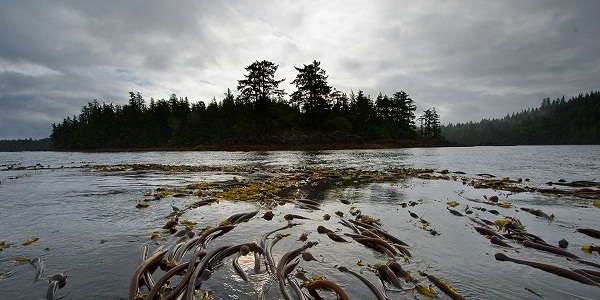A Double Threat
posted by: Administrator, April 9, 2012 at 11am
by Jens Wieting, Valerie Langer, and Eduardo Sousa
This is the final article in a three-part series on Canada’s Great Bear Rainforest. February marked the six-year anniversary of the Great Bear Rainforest Agreements, which were celebrated around the world as one of the greatest rainforest conservation stories of our time. To this day, however, half of the Great Bear Rainforest is still open to logging. Greenpeace, Sierra Club BC, and ForestEthics have launched a campaign calling on B.C. Premier Christy Clark to speed up the outstanding steps for healthy forests and thriving communities, before it’s too late. The first article discussed how the Great Bear Rainforest is still at risk. The second article described what makes the Great Bear Rainforest so significant – and worthy of full protection. This final instalment looks at the specific threat to the forest and its ecosystem from the proposed Northern Gateway Pipeline project.
Enbridge’s Northern Gateway Pipeline project, which is currently under federal government review, would send 200 supertankers (some larger than the Empire State Building) every year through the rocky and unpredictable waters of British Columbia’s iconic Great Bear Rainforest.
All it would take is one foul spill for the project to have a catastrophic effect on the economy, fisheries, and intertwined marine-forest ecosystem of the Great Bear Rainforest, as well as First Nations and other communities that live in, and depend on, it. A spill would also threaten to undo all the innovative and long-term forest conservation work environmental groups, First Nations, industry, and others, including the B.C. government, have accomplished in the last decade.
As many analysts have pointed out, it is not a matter of whether there will be an oil spill, but when.

Photo Credit: Andrew Wright
The B.C. government under Christy Clark has said it is waiting to hear the results of a joint review panel – one that is looking at the merits and risks of the proposed pipeline – before it takes a position. It is a worrisome stance.
The pipeline would run from Alberta’s oil sands across hundreds of pristine rivers and streams to Kitimat, where supertankers would pick up the unrefined crude. From there, the supertankers would travel through the turbulent coastal waters, passing Princess Royal Island – the stronghold of the spirit bear (a white variant of the black bear) – and crossing an ocean teeming with orcas, humpbacks, sea lions, and other rich marine life.
We know that the forest and sea here are intimately connected. The estuaries, where the saltwater channels merge with rivers, are one of the most biologically rich environments in the world. Deep in the temperate rainforest, both bears and wolves feast on salmon. The sea feeds the forest. The forest gives back to the sea.
More than 130 First Nations and 80 per cent of British Columbians oppose allowing oil tankers through the Great Bear Rainforest. Several B.C. municipalities have passed resolutions against the Enbridge project, adding to the Union of B.C. Municipalities’ broad resolution against tankers. The Communications, Energy and Paperworks Union of Canada, representing 150,000 Canadian workers (including most of the workers employed in the oil sands), is also opposed. And, since January, more than 45,000 Canadians have signed a petition opposing the pipelines and tankers.

Photo Credit: Andrew Wright
There is a stark contrast between the highly conflicted controversy over the Northern Gateway pipeline and tanker proposal and the collaborative process unfolding towards large-scale forest conservation and improved human well-being in the Great Bear Rainforest.
British Columbians and the world rallied around the global treasure to stop unsustainable industrial logging, and celebrated when a commitment to the Great Bear Rainforest’s long-term conservation was won in 2006.
When the agreement was announced, the world swooned over the spirit bear. The thousand-year-old trees, native cultures, and rich waterways inspired British Columbians, Canadians, and people around the world. The Great Bear Rainforest became a household name.
Unlike the Enbridge pipeline/tanker proposal, which puts the ecology and local economies of the region at great risk, the B.C. government’s commitment promised to preserve the Great Bear Rainforest and enhance the well-being of communities that live within, and depend on, it. However, that conservation agreement is only half finished and the Enbridge proposal fundamentally compromises it.
The B.C. government needs to finish what it started by fully implementing the rest of the agreement – 50 per cent of the forest is still open to logging. Independent science that underpins the agreement is clear that at least 70 per cent of the natural level of old-growth forest needs to be conserved. Otherwise, the rainforest is on an inevitable ecological decline, notwithstanding the negative impacts that the Enbridge Northern Gateway project would have.
The B.C. government has to follow through on its promise and fully implement the Great Bear Rainforest Agreements. But the province must also show leadership and stand in solidarity with the more than 130 First Nations and the majority of British Columbians against tankers and pipelines. The two commitments go hand in hand. We expect, and should demand, that the provincial government secure the tremendous investments it has made into the conservation of the Great Bear Rainforest, rather than doing a complete about-face and risking it all.
First published at: http://www.themarknews.com/articles/8379-a-double-threat